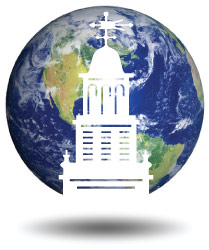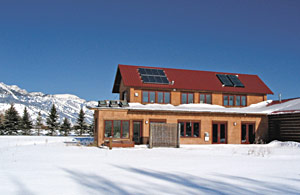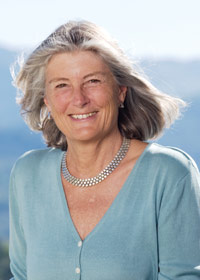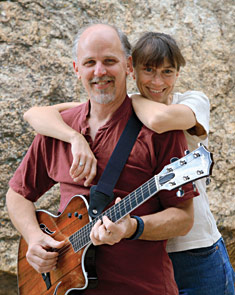
Blue Planet Turning Green
Global warming got you down? With dire prophecies of environmental catastrophe coming from all sources, it's easy to get discouraged. But thinking about the environment doesn't have to be all doom and gloom. Nancy H. Taylor '67 and Jennifer White '90, in their different ways, are spreading a positive message about how to save our planet.
Nancy H. Taylor '67 has been committed to environmental sustainability since the early 1970s. An early adopter of solar technology, she helped design her home in Jackson Hole, Wyo., which uses the sun for heat. Now she has released a book to share her knowledge with others. Go Green: How to Build an Earth-Friendly Community is a practical guide to living sustainably.
Practical is truly the key word. Without being sanctimonious or condescending, Go Green is a primer filled with useful, easy-to-follow steps that anyone can take to make changes in their own home and lifestyle. Ultimately, as indicated by the book's subtitle, Nancy points the way for people to carry these changes into the community—such as starting a recycling center or establishing community-supported agriculture (CSA). With a foreword by Patagonia founder Yvon Chouinard and an endorsement by environmental hero Bill McKibben, Go Green is essential reading for anyone who is ready to take action but doesn't know where to start.

Originally from the Chicago area, Taylor credits her experience at Colby-Sawyer for deepening her passion for the outdoors, a passion that grew into an environmental consciousness. A social worker by profession, she received her master's degree in social work from the University of California, Berkeley, in 1971. She first moved to Jackson Hole in 1973, bringing with her an idealism cultivated in the hotbed of Berkeley.
In the pristine Wyoming landscape Taylor found herself among people intent on preserving the beauty of their surroundings. With the environmental movement coming of age, she became involved with several organizations, including the Jackson Hole Conservation Alliance. Today, she is the vice president of the board.
By the early 1980s, Taylor had left Wyoming to move into a passive solar home in Bozeman, Mont., that she helped design and build. “It wasn't called green building then,” she recalls, and the home, the first of its kind in the area, was featured in Fine Homebuilding magazine. Passive solar by itself, though, has its limitations.
Relying exclusively on sunlight, without any mechanical system, it is dependent on optimum conditions. Taylor educated herself about active solar, which uses solar panels to generate electricity. Eventually she found herself back in Jackson Hole, where she built her current home. Combining passive and active solar, it is a model of green building. “The building industry has changed a great deal since I built my first house,” Taylor explains, “and many more nontoxic materials are available.”
As with her first green house, Taylor's home invited interest. A local environmental center asked her to teach a class on the art of green living and building. The course led to a column in a local weekly paper that ran for five years; the column led to her book deal.
Since Go Green's release in 2008, she has had speaking engagements on both coasts, as well as closer to home. Most exciting, she says, is being chosen by the U.S. Department of the Interior to speak at a conference this September, which seeks to teach government employees how to go green.

Taylor stresses that living a life of sustainability doesn't have to be a great sacrifice. “I want to emphasize that it's fun,” she exclaims. “I've seen people make tremendous changes and actually have fun doing it.”
Ever the optimist, Taylor has no doubt people can change their habits for the greater good. And really, what is the alternative? “Soiling our nest really isn't the best idea,” she says with a wry laugh. “This is the only planet we have and we need to take care of it.“
Nancy Taylor's Top Five Ways to Make Your Home More Energy Efficient
Change your light bulbs from incandescent bulbs to compact fluorescent light bulbs (CFLs). These are 75 percent more efficient and now offer the same warm light as traditional bulbs.
Get an energy audit. Either your utility company or an independent contractor can do a blower door test to find the air leaks in your house.
Turn down your hot water heater to 120 degrees. Insulate it with a special blanket if it is an older model.
Install a programmable thermostat so your furnace is turned down while the house is empty and turned up when you're about to come home.
Use Energy Star appliances and install power strips on all electronics. Turn the power strips off at night and save tremendous amounts of money and energy.
Learn more at www.nancyhtaylor.com.
For the past six years, Jennifer White '90 has performed with her husband, Jimmy Sferes, as the acoustic duo Sferes and White. They have released two CDs, played numerous shows and festivals, and performed for a radio audience of millions during an appearance on the National Public Radio favorite “A Prairie Home Companion.”
But White is not content to merely entertain. A founder of the Green Heart Institute and executive director of the Simplicity Forum, nonprofits committed in different ways to the idea of sustainability, she sees music as an ideal way to engage and enlighten people. And that's where Eco-Tones come in.
What are Eco-Tones? Essentially, they are specialized performances by Sferes and White, multi-media productions that weave music and visuals to entertain and educate the audience about environmental issues. Since beginning of the project in 2006, the duo has brought their Eco-Tones productions to various festivals, conferences and colleges, including Colby-Sawyer, in 2007.
“It's somewhere between a concert and a presentation,” explains Jennifer, speaking animatedly with a clear passion for her subject. “Usually you go to a conference and you hear a speaker. Or you go to a music festival and you hear a performer. We thought combining them might be a better way to engage people, and also a way to sneak in the information.”

The idea of music with a message might set off warning signals about preachy, over-earnest performers. White nods, clearly anticipating this line of thought.
“I've been an educator for 13 years,” she says, “and I hate being told what to do, even when it's something I know that I should do.” That's why Eco-Tones shows are filled with humor, and information is offered “as an invitation as opposed to a judgment.”
Of course, there's always the problem of simply preaching to the choir. White admits that those people are easy to engage. It's the people whom she refers to as in the “fixin' to get ready” stage who need a little more encouragement. “Maybe when they listen to us we can nudge them along, get them closer to the action stage.”
White, who grew up in New London (and is the daughter of Gretchen Hoch White '53), has an interesting background. After receiving her associate's degree from Colby-Sawyer she moved to Colorado, where she earned a bachelor's degree in physics from Colorado College and a master's degree in somatic psychotherapy from Naropa University.
Being versed in physics and psychology perhaps explains her holistic approach, seeing sustainability as not merely an environmental concept, but part of a larger system. As she says, “You can be the most environmentally sustainable person on the planet, but if you can't pay your bills or you don't live in a safe community, then that's not really sustainable.”
White and Sferes recently left Colorado to return to New London, a move precipitated by the death of her father in October 2008. Despite the upheaval in their lives, the duo plan to keep spreading their green message with Eco-Tones performances. There's also a book in the works, a light-hearted approach to sustainable living that White describes as a cross between Erma Bombeck and Rachel Carson.
As she points out, “If you focus on the doom and gloom, people just get depressed and shut down. It's important to have a positive vision for what this could be.”
Jennifer White's Top Five Ways to Take Action
Start turning off the lights: tackle home energy efficiency and conservation.
Take a walk or ride a bike: consider alternative and fuel-efficient transportation.
Grab a local, organic bite: eat nearby and lower on the food chain.
Try to live a simpler life: use fewer resources and buy less stuff.
Pass it on with all your might: help others learn what they can do, too.
Learn more at www.eco-tones.com.
-by Mike Gregory


